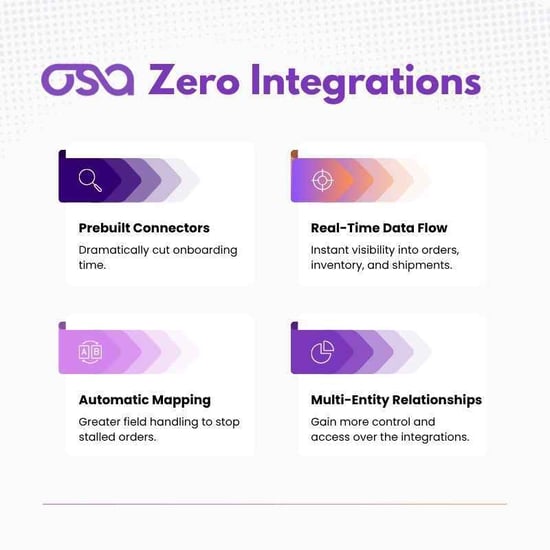4 min read
The Quiet Problem Slowing Down 3PLs and Brands: Broken Integrations
![]() Osa Commerce
:
November 18, 2025
Osa Commerce
:
November 18, 2025

If you spend any time around fulfillment teams or e-commerce operators, you start to see a pattern: most of the daily chaos has nothing to do with labor shortages or warehouse space. It’s integrations — systems that don’t sync, data that shows up late, or fields that don’t match.
And when those connections fail, supply chain operations get harder to manage. Service level agreements (SLAs) slip, inventory gets out of sync, and the customer experience takes the hit.
Broken integrations within your supply chain ecosystem can be a silent killer to data accuracy and efficiency. Check out these real-world examples and see if any of them sound familiar.
Where Things Break (Actual Situations Everyone Has Seen)
Even the best-run third-party logistics (3PLs) partners and brands run into the same set of problems — not because their teams aren’t strong, but because their systems weren’t built to keep up with the pace of modern commerce. When legacy tools, channel connectors, enterprise resource planning systems (ERPs), and warehouse management systems (WMS) platforms all operate on different clocks and data structures, small mismatches can turn into major operational issues.
These breakdowns show up in very familiar ways — inventory discrepancies, missing ASNs, frozen wholesale orders, and carrier code mismatches. And once they happen, the entire fulfillment cycle feels the impact. Here are the real situations where these cracks appear first.
Carrier Mappings that Change the Entire Day
You’d be surprised how often this happens.
Your WMS sends “2 day,” but the carrier expects “EXPRESS.” Everything defaults to Ground.
Customers blame the brand. Ops teams spend the afternoon fixing it. 3PL partners take a revenue hit.

How Good Integrations Help (Real Situations Where They Save the Day)
The flip side is just as true: when integrations are clean, real-time, and built to handle multi-channel complexity, everything downstream becomes easier. Orders move faster, inventory stays accurate, exceptions get caught early, and fulfillment teams stop living in constant recovery mode.
Strong integrations don’t just “move data” — they prevent the problems that consume hours of operational time every week. These are the moments where good connectivity transforms the entire day.
1. Real-time inventory avoids oversells
A brand pushes a flash sale on Instagram. Traffic spikes. Normally, channels oversell because inventory updates lag. With clean real-time integrations:
- WMS pushes every pick, stow, and adjustment instantly
- OMS updates channel availability within seconds
- Amazon, Shopify, TikTok, and wholesale portals all stay aligned
The sale runs smoothly — no cancellations, no apologetic emails.
2. Faster order drops prevent late shipments
Orders that used to hit the WMS in batches every 15–30 minutes now drop instantly. This makes a massive difference:
- Morning orders actually go out the same day
- Cutoff times get extended because the floor isn’t waiting on data
- Carriers can pick up more volume without risking SLA misses
A 10-second delay versus a 20-minute delay can be the difference between meeting USPS cutoff or missing it entirely.
3. Auto-validation catches errors before they reach the warehouse
Instead of ops teams discovering bad orders at the packing station, unified integrations:
- Validate addresses
- Normalize carrier codes
- Flag missing fields
- Check for invalid SKUs
- Reroute orders based on logic (backorders, multi-warehouse logic, etc.)
It prevents exceptions from ever hitting the floor.
4. ASNs sync cleanly, so receiving is planned instead of chaotic
When ASNs reliably reach the WMS:
- Dock teams know what’s coming
- Receiving can allocate labor ahead of time
- Putaway starts immediately
- Inventory becomes available for sale faster
For brands, this means less “out of stock” time on items that are literally in the building.
5. Multi-warehouse routing becomes a strength, not a guessing game
Good integrations let the OMS automatically pick the best ship-from location:
- Closest to the customer
- Enough stock on-hand
- Meets cutoff
- Lowest cost to ship
This can reduce shipping cost by 10–20% — without changing anything operationally.
6. Wholesale orders stop breaking every time a retailer changes something
With a strong integration layer:
- New EDI fields get mapped automatically
- Validations catch mismatches upfront
- Acknowledgments flow instantly
Instead of scrambling, teams just work.
Where Osa Commerce Fits Into All This
This is the space Osa Commerce leans into — not by adding more systems, but by making the existing ones work together properly.
Here’s how Osa Zero Integrations help:
Prebuilt connectors that actually reflect how supply chains work
Instead of building custom connections every time a brand adds a new channel or ERP, Osa has preset integrations ready to go. That alone cuts onboarding timelines dramatically.
Real-time data flow
Orders, inventory, shipments — everything moves across systems instantly, not in slow batches.
Automatic mapping and field handling
If a channel or retailer changes a field, Osa catches it before it turns into a pile of stalled orders.
Built for the 3PL, Brand, and Channel model
Most integration tools weren’t designed for multi-entity relationships.
Osa Zero Integrations is — and it removes much of the back-and-forth that usually happens.
One place to see when something’s off
If one system breaks, you don’t find out at 4 PM when orders miss the cutoff.
You see it early, fix it fast, and keep things moving. Osa Zero can be configured to send automated email alerts to the clients detailing any failure. This greatly reduces time spent on error detection and communication.
The goal isn’t just exchanging data — it’s keeping operations predictable.
Stop Constant Fire Drills
Integrations used to be pushed to the bottom of the list. Now integrations are what separate smooth operations from constant fire drills.
The more channels brands sell through and the more systems 3PLs run, the more important it becomes to have a clean, reliable integration layer underneath it all.
Osa Zero Integration Management helps both sides cut down the noise, reduce the daily friction, and keep everything in sync without duct-taping workflows together.
If the integrations are solid, the rest of the operation feels lighter. If they’re not, nothing ever runs the way it should.
Interested in learning how to maximize your supply chain? Speak with an Osa Commerce expert.






